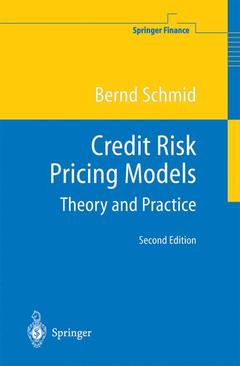Description
Credit Risk Pricing Models (2nd Ed., 2nd ed. 2004)
Theory and Practice
Springer Finance Series
Author: Schmid Bernd
Language: English
Subjects for Credit Risk Pricing Models:
Credit risk pricing models
Publication date: 03-2011
383 p. · 15.5x23.5 cm · Paperback
Publication date: 03-2011
383 p. · 15.5x23.5 cm · Paperback
Credit risk pricing models : Theory & practice, (2nd Ed.)
Publication date: 01-2004
383 p. · 15.5x23.5 cm · Hardback
Publication date: 01-2004
383 p. · 15.5x23.5 cm · Hardback
Description
/li>Contents
/li>Comment
/li>
This new edition is a greatly extended and updated version of my earlier monograph "Pricing Credit Linked Financial Instruments" (Schmid 2002). Whereas the first edition concentrated on the re search which I had done in the context of my PhD thesis, this second edition covers all important credit risk models and gives a general overview of the subject. I put a lot of effort in explaining credit risk factors and show the latest results in default probability and recovery rate modeling. There is a special emphasis on correlation issues as well. The broad range of financial instruments I consider covers not only defaultable bonds, defaultable swaps and single counterparty credit derivatives but is further extended by multi counterparty in struments like index swaps, basket default swaps and collateralized debt obligations. I am grateful to Springer-Verlag for the great support in the realiza tion of this project and want to thank the readers of the first edition for their overwhelming feedback. Last but not least I want to thank Uli Göser for ongoing patience, en couragement, and support, my family and especially my sister Wendy for being there at all times. BemdSchmid Stuttgart, November 2003 Cpntents 1. Introduction. . . . . . . . . . . . . . . . . . . . . . . . . . . . . . . . . . . . . . . . . . . . . . 1 1. 1 Motivation. . . . . . . . . . . . . . . . . . . . . . . . . . . . . . . . . . . . . . . . . . . . 1 1. 2 Objectives, Structure, and S:ummary . . . . . . . . . . . . . . . . . . . . . . 5 2. Modeling Credit Risk Factors. . . . . . . . . . . . . . . . . . . . . . . 13 . . . . . . 2. 1 Introduction. . . . . . . . . . . . . . . . . . . . . . . . . . . . . . . . . . . . . . . . . . . 13 2. 2 Definition and Elements of Credit Risk . . . . . . . . . . . . . . .. 13 . . . . 2. 3 Modeling Transition and Default Probabilities. . . . . . . . . . . . . 14 . 2. 3. 1 The Historical Method . . . . . . . . . . . . . . . . . . . . . . 15 . . . . . .
1. Introduction.- 1.1 Motivation.- 1.2 Objectives, Structure, and Summary.- 2. Modeling Credit Risk Factors.- 2.1 Introduction.- 2.2 Definition and Elements of Credit Risk.- 2.3 Modeling Transition and Default Probabilities.- 2.4 Modeling Recovery Rates.- 3. Pricing Corporate and Sovereign Bonds.- 3.1 Introduction.- 3.2 Asset Based Models.- 3.3 Intensity Based Models.- 4. Correlated Defaults.- 4.1 Introduction.- 4.2 Correlated Asset Values.- 4.3 Correlated Default Intensities.- 4.4 Correlation and Copula Functions.- 5. Credit Derivatives.- 5.1 Introduction to Credit Derivatives.- 5.2 Technical Definitions.- 5.3 Single Counterparty Credit Derivatives.- 5.4 Multi Counterparty Credit Derivatives.- 6. A Three-Factor Defaultable Term Structure Model.- 6.1 Introduction.- 6.2 The Three-Factor Model.- 6.3 The Pricing of Defaultable Fixed and Floating Rate Debt.- 6.4 The Pricing of Credit Derivatives.- 6.5 A Discrete-Time Version of the Three-Factor Model.- 6.6 Fitting the Model to Market Data.- 6.7 Portfolio Optimization under Credit Risk.- A. Some Definitions of S&P.- A.1 Definition of Credit Ratings.- A.1.1 Issue Credit Ratings.- A.1.2 Issuer Credit Ratings.- A.2 Definition of Default.- A.2.1 S&P’s definition of corporate default.- A.2.2 S&P’s definition of sovereign default.- B. Technical Proofs.- B.1 Proof of Lemma 6.2.1.- B.3 Proofs of Lemma 6.3.1 and Lemma 6.4.2.- B.4 Proof of Lemma 6.4.3.- B.5 Tools for Pricing Non-Defaultable Contingent Claims.- C. Pricing of Credit Derivatives: Extensions.- List of Figures.- List of Tables.- References.
Contains the latest developments in credit risk research Gives a broad overview of credit risk models
© 2024 LAVOISIER S.A.S.




